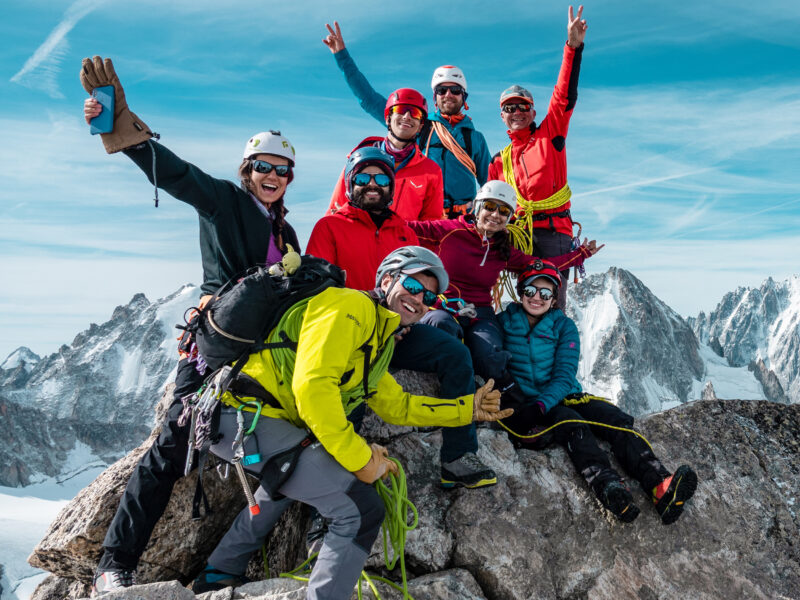BY Anthony Mezher | October 08 2022
How to Train For Mountains in Desert Countries

In case you haven’t noticed, Gulf-based athletes have been regularly achieving the summits of the highest mountains on the planet including the likes of K2, Annapurna, Manaslu and Everest. A good question to ask is how on Earth the land of sand is producing explorers of the ice and the altitude and how are they training for it back home?
Of course, mountaineers who live and train in higher places have a more ideal situation. They are better able to stay acclimatized and are generally quite used to the cold. There are no such places in Saudi Arabia, Kuwait or UAE and as much as we try to find any opportunity to wear a down jacket or dry tool with an Ice Axe, the truth is that the outdoors environment at home really requires minimum clothing. So, trying gear and clothes before using them on an expedition is pretty much out of the question too! As you can imagine, you’d want to break in your high-altitude boots before putting them on at crampon point above 5000 meters on a trip to the Himalayas. Especially if you’d like to avoid painful blisters.
So, what are some of the practical ways in which we can actually get ourselves mountain-ready? The answers are actually with those of us who live around the gulf and are actively tackling mountains.
Indoor Ski Areas & Regional Resorts
It may not be ideal but for most of us places like Ski Dubai are the only ice we’ll ever experience before a real expedition. At Ski Dubai, an indoor ski slope located at the Mall of the Emirates, climbers can use their boots and gear, train on the slope and experience sub-zero temperatures. It’s even possible to arrange an overnight stay in a tent. Doing laps on the slopes are a sure way to test out gear and get the body used to being in colder environments. Natural alternatives to Ski Dubai in the Gulf are the regional ski areas like Lebanon, Georgia and Armenia. Weekend getaways do these destinations can go a long way to preparing us for adventures to come.
Wim Hof Ice Baths
The Wim Hof ice bath craze has become a regular sighting across the Gulf. Basically, the idea is to take a plunge is ice cold water and try to stay in as long as possible. This helps us understand how the body reacts to cold temperatures and is a favorite of LHO founder Rami although he prefers naturally freezing water whenever possible. I personally witnessed him “chillaxing” in the ice waters of mount Chimborazo in Ecuador, doing breathing exercises and maintaining his focus. Yes, being in ice cold water has A LOT of benefits, improves muscles recovery and skin, helps you focus, gives you better breathing, decreases inflammation in your body, improves blood circulation and, of course, accustoms the body to being around cold. I’ve also seen Nelly Attar, who recently became the first Arab to summit K2, training in Saudi by putting her hands/fists into the frozen ice while planking. That’s a hardcore one there Nelly!

Terrain
Hot countries might not have mountains, but some of them have Towers. Before you laugh, imagine a 70-story tower with 4 meters between each floor. That’s an immediate access to 280meters of direct ascent with hardly any horizontal distance. Doing it 4 times gives you a 1000-meter elevation gain and that’s more training than most people who have access to mountains can normally do. Do this over a few days and my friend, you have done the summit of Kilimanjaro in less than a week’s time from sea level! True, the altitude element is not a factor, but your legs would have felt the load, especially if you are carrying a bag!
When you don’t have a tower, there is of course the desert. Dunes are actually very beneficial and have almost the same effect on our muscles as fresh deep snow. Going up a dune will make you feel like time has stopped and you just aren’t moving. Every step forward can feel like 5 as the feet slide back with the cascading sand. You’ll find more similarities between sand and snow then you would between a dry mud trail in the lower altitudes of most mountainous regions. If you want to take it a step further, try doing it in the heat! The mental strength you need to get through that will rival the Everest summit push from the South Col!
The Heat
New studies are finding that hot weather and thin air trigger similar physiological adaptations. Lately, heat adaptation has been one of the hottest topics in the world of athletic endurance. It’s being considered a more accessible version of altitude training, although the research on this is thin a best. But even still, if the physiological affects are debatable, the psychological effects are very real.
You’ll find more similarities between sand and snow then you would between a dry mud trail in the lower altitudes of most mountainous regions.
The truth is that when there is a will there is a way. For those of us who’d like to make excuses there are plenty to go around. I know people who live at the foot of the Mont Blanc who have plenty of excuses too! But, if you want to make these types of adventures possible, just take a look at the growing number of desert-based mountaineers. There are plenty of creative ways to train and prepare for the summits of the world right here at home!
About Life Happens Outdoors
At Life Happens Outdoors, we believe in the power of nature to transform lives. As proud members of the Adventure Travel Trade Association (ATTA) and the World Travel & Tourism Council (WTTC), our team of certified guides and outdoor professionals is committed to the highest standards of safety, sustainability, and excellence.
Discover more about our story and mission on our Meet LHO page, or explore our curated adventures such as the Tour du Mont Blanc Trek, the Climb of Kilimanjaro, and Chasing the Northern Lights.















